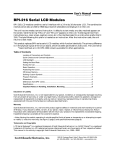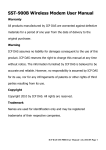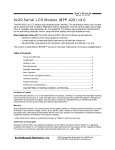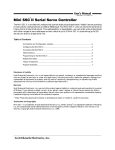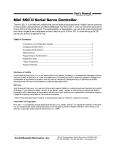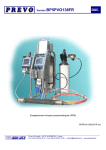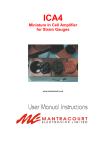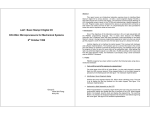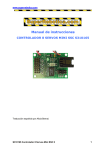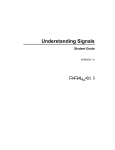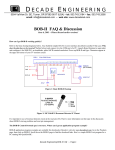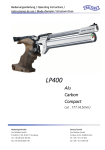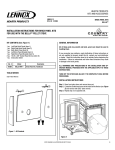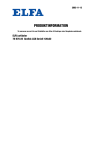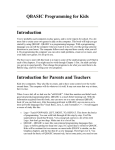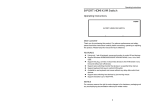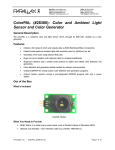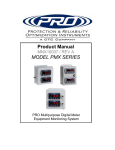Download LCD Serial Backpack® and 2x16 Serial LCDs
Transcript
User’s Manual
BPK-XXX • v6.0 • 03/98 • pg 1
LCD Serial Backpack® and 2x16 Serial LCDs
The LCD Serial Backpack® is a daughterboard that attaches to standard character LCD modules. It
receives data serially and displays it on the LCD. The Backpack supports any alphanumeric LCD up
to 80 screen characters (e.g. 4 lines by 20 characters). It accepts serial data at 2400 or 9600 baud (switch
selectable). It is sold by itself, or preinstalled to high-quality 2x16 LCD modules.
The Backpack has two modes: text and instruction. It defaults to text mode; any data sent to the
Backpack is displayed on the screen. Send the string “HELLO” and “HELLO” appears on the LCD. To
distinguish text from instructions (e.g., clear screen, position cursor, etc.), the Backpack looks for an
instruction prefix (ASCII 254). The byte following prefix is treated as an instruction. After the instruction
code, the Backpack returns to text mode.
Table of Contents
Description and Installation to Typical LCDs.............................................................................2
Quick Checkout and Contrast Adjustment ................................................................................2
Configuration.............................................................................................................................3
Hookup for Use .........................................................................................................................3
Basic Operation.........................................................................................................................3
Positioning the Cursor...............................................................................................................4
Defining Custom Symbols.........................................................................................................5
Program Examples....................................................................................................................7
Dimensions ...............................................................................................................................8
Backlight Hookup ......................................................................................................................8
Revision History ........................................................................................................................8
Specifications ............................................................................................................................8
Disclaimer of Liability
Scott Edwards Electronics, Inc. is not responsible for any special, incidental, or consequential damages resulting
from any breach of warranty, or under any legal theory, including lost profits, downtime, goodwill, damage to or
replacement of equipment or property, and any costs or recovering, reprogramming, or reproducing of data
associated with the use of the hardware or software described herein.
Warranty
Scott Edwards Electronics, Inc. warrants this product against defects in materials and workmanship for a period
of 90 days. If you discover a defect, we will, at our option, repair, replace, or refund the purchase price. Return
the product with a description of the problem. We will return your product or its replacement via standard shipping.
Expedited shipping is available at the customer’s expense.
• Note: Physically abusing the module, or attempting to repair or modify it, voids this warranty.
Trademarks and Copyrights
LCD Serial Backpack® is a registered trademark of Scott Edwards Electronics, Inc.; BASIC Stamp® is a registered
trademark of Parallax Inc. All trademarked names referenced herein are the property of their respective holders.
This manual in its entirety is copyright Scott Edwards Electronics, Inc., 1998.
Scott Edwards Electronics, Inc.
2700 E. Fry Boulevard, Suite A4, Sierra Vista, AZ 85635 USA
ph: 520-459-4802 • fax: 520-459-0623 • Net: www.seetron.com
User’s Manual
BPK-XXX • v6.0 • 03/98 • pg 2
Description of the Backpack Board, Installation to Typical LCDs
Figure 1 shows the major features and configuration options of the Backpack circuit board. Figure 2
shows how to mount it to typical LCD modules.
+5V
Contrast
(darker)
GND
Serial data
LINES switch
Duplicate +5V and GND
connections (see text)
(down = 1-line LCD; up = multiline LCD)
BPS switch
(down = 2400 baud; up = 9600 baud)
Do not reverse +5V and GND, even momentarily. Reversed power will destroy the electronics.
Do not exceed 5.5V into +5V. Overvoltage will damage the unit or shorten its life.
Figure 1. The LCD Serial Backpack® circuit board.
LCD connector styles that
work best with the Backpack
(component-side view of LCD)
pin 1
UP
Backpack,
component-side up
1x14 connector
1x14 connector
1x14 connector
Peel and stick
foam tape as
shown. Slide
Backpack J3
over header
stakes and
solder.
Solder header stakes to LCD 1x14 pads.
Backpack,
component-side up
Peel and stick
foam tape as
shown. Slide
Backpack J2
over header
stakes and
solder.
pin 1
pin 14
2x7 connector
pin 1
2x7 connector
Solder header stakes to LCD 2x7 pads.
LCD module, face down
foam tape
LCD module, face down
foam tape
Figure 2. Mounting the Backpack to an LCD.
Quick Checkout and Contrast Adjustment
You can test the Backpack and LCD for proper operation without a computer/serial port. Temporarily
connect the serial input to one of the +5 terminals of J1, then connect power to +5 and GND. Backpacks
with pcb revs 5 and 6 made before March 1998 will display rows of triangles across the display. Later
rev 6 and higher units (ones shipped with this manual) will display a text message. Units earlier than
rev 5 will produce unpredictable results with this test, so they should be tested with an actual serial
input.
The contrast control is usually set fully clockwise at the factory. This setting may be too dark with
some LCDs. Use a small, flat-blade screwdriver to adjust the contrast.
Scott Edwards Electronics, Inc.
2700 E. Fry Boulevard, Suite A4, Sierra Vista, AZ 85635 USA
ph: 520-459-4802 • fax: 520-459-0623 • Net: www.seetron.com
User’s Manual
BPK-XXX • v6.0 • 03/98 • pg 3
Configuration
Display Lines: Set the LINES switch (figure 1) down for 1-line displays; up for 2- or 4-line displays.
Note that most 1x16 displays behave like 2x8 displays (with the two lines side by side). If you have a
1x16 LCD and cannot see the second eight characters, power down and switch to the 2-/4-line setting.
Baud Rate: Set the BPS switch down for 2400 baud; up for 9600. At either rate, the serial characteristics
are no parity, 8 data bits, 1 stop bit.
NOTE: The Backpack reads the configuration switches only at startup. Change switch settings only
with the power off.
Hookup for Use
Figure 3 shows how to connect the LCD Serial Backpack® to PCs and BASIC Stamp computers in order
to run the example programs presented later in this manual. Refer to figure 1 or the markings on the
Backpack for the locations of +5, GND and SER(ial in).
The 5-pin connector on the Backpack has two extra pins for +5 and GND. These pins are arranged in
a pallindrome layout. If you make a matching 5-pin connector, the connections will always line up
properly regardless of connector orientation. Suitable female crimp sockets for making connectors are
available from Jameco (www.jameco.com, PN: 100765). Digi-Key carries ready-made 5-pin socket and
flex-cable assemblies in varying lengths (www.digikey.com, PN: A9BAG-0506F-ND).
PC Serial (comm) Port
BASIC Stamps
Backpack
DB-9 female
(solder side)
1
2
3
4
7
8
Backpack
SER
GND (Vss)
GND
+5V (Vdd)
GND
5
+5
6
Stamp
+5
9
I/O pin 0
+5
SER
power
supply
Figure 3. Connecting to PC serial port, BASIC Stamps.
Basic Operation
Once the Backpack is properly connected and configured to match the baud rate of the computer/program
that will be talking to it serially, data sent to the Backpack will appear on the display. For example,
if you send “Hello” to the Backpack, “Hello” appears on the display. The cursor (printing position)
automatically advances from left to right.
You can also send instructions to the LCD via the Backpack. To tell the Backpack that a particular
byte is an instruction and not text, precede it with the instruction prefix character, ASCII 254 (0FE
hex, 11111110 binary). The Backpack treats the byte immediately after the prefix as an instruction,
then automatically returns to data mode.
An example: The clear-screen instruction is ASCII 1. To clear the screen, send <254><1> (where the
<> symbols mean single bytes set to these values, not text as typed from the keyboard). Table 1 lists
the LCD instructions.
Scott Edwards Electronics, Inc.
2700 E. Fry Boulevard, Suite A4, Sierra Vista, AZ 85635 USA
ph: 520-459-4802 • fax: 520-459-0623 • Net: www.seetron.com
User’s Manual
BPK-XXX • v6.0 • 03/98 • pg 4
Table 1. LCD Instructions
Instruction/Action
Clear Screen
Scroll display one character left (all lines)
Scroll display one character right (all lines)
Home (move cursor to top/left character position)
Move cursor one character left
Move cursor one character right
Turn on visible underline cursor
Turn on visible blinking-block cursor
Make cursor invisible
Blank the display (without clearing)
Restore the display (with cursor hidden)
Set cursor position (DDRAM address)
Set pointer in character-generator (CG) RAM
Code
1
24
28
2
16
20
14
13
12
8
12
128 + addr
64 + addr
These instructions take more than 1 ms for the LCD to execute. Pause at least 1 ms before
sending additional data after these instructions. At 2400 bps, no pause is ever needed.
Advanced LCD users: These are the actual LCD instruction codes. When the Backpack receives the instruction prefix, it clears
the register select (RS) bit. The next received byte is written to the LCD with RS low. After writing that byte, it returns RS high
(normal data mode). This approach means that you can send any valid LCD instruction through the Backpack. Since the
Backpack intializes the LCD at startup, you should not send any initialization instructions. If you did not understand the preceding
note, don’t worry. You don’t need to know any of this to use an LCD with the Backpack. The info may be handy to advanced
users adapting programs written to drive the Backpack to applications that drive the LCD directly through the parallel bus.
Positioning the Cursor
You can position the cursor anywhere on the screen by sending the proper instruction. The arrangement
of character positions depends on the type of LCD, as shown in figure 4 below.
one-line LCDs
1x16 LCDs
(other than 1x16; set LINES switch to 1)
(set LINES switch to 2/4)
character
position
0
set-position
instruction
1
2
3
4
5
6
128 129 130 131 132 133 134
two-line LCDs
0
set-position
instruction
1
2
8
128 129 130
9 10
192 193 194
four-line LCDs
(set LINES switch to 2/4)
0
character
position
1
2
(set LINES switch to 2/4)
3
4
5
6
0
1
2
3
4
5
6
line 1
128 129 130 131 132 133 134
line 1
128 129 130 131 132 133 134
line 2
192 193 194 195 196 197 198
line 2
192 193 194 195 196 197 198
line 3
148 149 150 151 152 153 154
line 4
212 213 214 215 216 217 218
To position the cursor, send the instruction-prefix
byte, ASCII 254, followed by the set-position byte
value. For example, to move to line 2, character 4,
send <254><196>. Note: <#> means a byte set to
the value #. See program examples.
Scott Edwards Electronics, Inc.
Figure 4. Cursor positioning.
2700 E. Fry Boulevard, Suite A4, Sierra Vista, AZ 85635 USA
ph: 520-459-4802 • fax: 520-459-0623 • Net: www.seetron.com
User’s Manual
BPK-XXX • v6.0 • 03/98 • pg 5
Defining Custom Symbols
Most of the LCD characters (figure 6) cannot be changed because they are stored in ROM. However,
the first eight symbols, corresponding to ASCII 0 through 7, are stored in RAM. By writing new values
to the character-generator (CG) RAM, you can alter these characters. Changing a symbol is easy; just
point to the beginning of the symbol’s RAM location, then write eight bytes whose bits form the desired
pattern. Then position the cursor onto the screen. See figure 5.
Manipulating custom characters allows you to create all kinds of special effects, including simple
animations. See the Backpack application notes at www.seetron.com for more examples.
Symbol Locations
Byte Values
bit 0
bit 1
bit 2
bit 3
bit 4
Bitmap Layout
byte 0
binary
xxx00000
decimal
0
byte 1
xxx00100
4
byte 2
xxx00010
2
byte 3
xxx11111
31
byte 4
xxx00010
2
byte 5
xxx00100
4
byte 6
xxx00000
0
byte 7
xxx00000
0
ASCII
Code
Base
Address
0
1
2
3
4
5
6
7
64
72
80
88
96
104
112
120
Example: Loading the Symbol
To load the arrow shown at left to symbol 3,
a program would send the following bytes to
the LCD:
<254><88>
' Point to symbol 3
<0><4><2><31>
<2><4><0><0>
' Send the bit
' pattern
<254><128>
' Move cursor back
' to the screen
<#> means a byte set to the value #.
See the program examples.
Figure 5. Defining custom symbols.
0
32
40
48
56
64
72
80
88
96
104 112 120 160 168 176 184 192 200 208 216 224 232 240 248
0
1
2
3
4
5
6
7
NOTE: Custom characters occupy ASCII 0—7
Backpack loads patterns shown at startup.
ASCII 8—31 repeat the custom characters
ASCII 128–160 are blanks
To find the ASCII code for a given character, add the row and column numbers.
For example, capital D is in the column marked 64 in row 4, so its ASCII code is
68. Use the reverse procedure to determine the symbol for a given code. For
example, ASCII code 244 produces the symbol Ω, found at colum 240, row 4.
Figure 6. LCD character set.
Scott Edwards Electronics, Inc.
2700 E. Fry Boulevard, Suite A4, Sierra Vista, AZ 85635 USA
ph: 520-459-4802 • fax: 520-459-0623 • Net: www.seetron.com
User’s Manual
BPK-XXX • v6.0 • 03/98 • pg 6
Program Examples
Any computer/programming language that can produce serial output (2400 or 9600 bps, N81) can talk
to the LCD Serial Backpack®. The examples here are in BASIC, chosen because of its popularity and
readability. Don’t be put off by the size of the programs—they are mostly comments.
These examples are meant to illustrate only the fundamentals. More elaborate examples are available
from www.seetron.com.
'
'
'
'
'
Program: BPKDEMO.BAS
This program demonstrates fundamental techniques of driving the
LCD Serial Backpack (R) in BASIC (compatible with QBASIC, Quick BASIC,
First BASIC, and Power BASIC). First BASIC, an excellent shareware
compiler, is available from www.powerbasic.com.
' Start by defining some useful constants for the Backpack
I = 254
' Instruction prefix value.
CLR = 1
' LCD clear-screen instruction.
LINE1 = 128
' Address of first character of 1st line.
LINE2 = 192
' Address of first character of 2nd line.
' Open the serial port (com1) for output at 9600 baud. Make sure Backpack
' is also set for 9600. Turn off all handshaking (CD, CS, DS) by
' setting to zero (0).
OPEN "COM1:9600,N,8,1,CD0,CS0,DS0" FOR OUTPUT AS #1
' Once the port is open, we can print to it. Start by clearing the screen
' in case there's text left from a previous run of this program. Note that
' at 9600 baud, you need a delay after clearing the screen. To create a
' delay, you can use a timing instruction such as First/Power BASIC's
' DELAY or QBASIC's SLEEP, or you can send an unnecessary instruction,
' such as <254><128>. That sequence moves the cursor to the beginning of
' line 1, which is where it already is, thanks to clear-screen.
PRINT #1, CHR$(I); CHR$(CLR);
' Send <254><1> to clear screen.
PRINT #1, CHR$(I); CHR$(LINE1); ' Time delay (for 9600 baud).
' Now print some text. PRINT statements should end with ; to
' prevent unnecessary carriage return/line feeds (which the Backpack
' doesn't understand, and displays as junk characters).
PRINT #1, "Hello world!";
Quickie Program
Want fast results? All you
need are these two lines
of code. The first opens
the serial port for output;
the second ‘prints’ text to
it.Type and run these lines
in QBASIC or Power
BASIC and “Hello World!”
appears on the display.
' Positioning the cursor requires sending the instruction prefix (ASCII
' 254, which we've assigned the name "I") followed by an address. We've
' assigned names to ASCII 128 (1st character of line 1) and 192 (1st
' character of line 2). We'll position the cursor to the start of
' line 2 and print some more.
PRINT #1, CHR$(I); CHR$(LINE2); "press return";
' Wait for a keypress (at PC) before continuing.
CLS : INPUT "PRESS RETURN TO CONTINUE", X$
' Now we'll simulate a common application by printing a label on the
' screen, then updating some data by positioning the cursor. Each
' time you press return on the PC, the program will add 1 to the
' count and update the value on the screen. Notice that to position
' the cursor at character 6 of line 1, we give the position value of
' LINE1 + 6. This is easier to read than 134, which is the address of
' line 1, character 6. Also note that we print several spaces after
' the number. It's not needed here, but in programs in which a number
' could be _lower_ than the previously displayed value, the spaces
' would erase any leftover digits.
PRINT #1, CHR$(I); CHR$(CLR); CHR$(I); CHR$(LINE1);
PRINT #1, "Count: "; CHR$(I); CHR$(LINE2); "press return";
theCount = 0
Again:
PRINT #1, CHR$(I); CHR$(LINE1 + 6); theCount; "
";
INPUT "ENTER TO CONTINUE, Q-ENTER TO QUIT ", X$
IF UCASE$(X$) = "Q" THEN END
theCount = theCount + 1
GOTO Again
Scott Edwards Electronics, Inc.
2700 E. Fry Boulevard, Suite A4, Sierra Vista, AZ 85635 USA
ph: 520-459-4802 • fax: 520-459-0623 • Net: www.seetron.com
User’s Manual
BPK-XXX • v6.0 • 03/98 • pg 7
'
'
'
'
'
Program: BPKDEMS1.BAS
This program demonstrates fundamental techniques of driving the
LCD Serial Backpack (R) in BASIC from the BASIC Stamp I. It assumes
that the Backpack is connected to I/O pin 0 of the Stamp, and
that it is set for 2400 bps.
' Start by defining some useful
SYMBOL I
=
254
'
SYMBOL CLR
=
1
'
SYMBOL LINE2
=
192
'
SYMBOL L1_C7
=
135
'
constants for the Backpack.
Instruction prefix value.
LCD clear-screen instruction.
Address of 1st char of 2nd line.
Address of line 1, character 7.
' Now clear the screen in case there's text left from a previous
' run of the program. Note that there's a 1-second PAUSE prior to
' sending any data to the Backpack. This gives the Backpack plenty
' of time to initialize the LCD after power up.
pause 1000
serout 0,n2400,(I,CLR)
' Clear the LCD screen.
serout 0,n2400,("Hello World!")
' Print message.
' Positioning the cursor requires sending the instruction prefix (ASCII
' 254, assigned the symbol "I") followed by an address.
serout 0,n2400,(I,LINE2,"..line 2")
' Move to line 2 and print.
' Now we'll simulate a common application by printing a label on the
' screen and updating some data by positioning the cursor.
pause 2000
' Wait 2 secs.
serout 0,n2400,(I,CLR)
' Clear the LCD screen.
serout 0,n2400,("Count:")
' Print the label.
Again:
serout 0,n2400,(I,L1_C7)
' Move to line 1, character 7.
serout 0,n2400,(#b2," ")
' Print value of b2 followed by 2 spaces.
b2 = b2+1
' Increment b2.
pause 200
' Slow the loop down.
goto Again
' Repeat endlessly.
'
'
'
'
'
Quickie Program
Type and run just this line
in PBASIC 1 and “Hello
World!” appears on the
display.
Program: BPKDEMS2.BS2
This program demonstrates fundamental techniques of driving the
LCD Serial Backpack (R) in BASIC from the BASIC Stamp II. It assumes
that the Backpack is connected to I/O pin P0 of the Stamp, and
that it is set for 9600 bps.
' Start
N9600
I
CLR
LINE2
L1_C7
by defining some useful constants for the Backpack.
con
$4054
' Baudmode for 9600 bps inverted.
con
254
' Instruction prefix value.
con
1
' LCD clear-screen instruction.
con
192
' Address of 1st char of 2nd line.
con
135
' Address of line 1, character 7.
' Now clear the screen in case there's text left from a previous
' run of the program. Note that there's a 1-second PAUSE prior to
' sending any data to the Backpack. This gives the Backpack plenty
' of time to initialize the LCD after power up.
pause 1000
serout 0,n9600,[I,CLR]
' Clear the LCD screen.
pause 1
serout 0,n9600,["Hello World!"]
' Print message.
Quickie Program
Type and run just these
lines in PBASIC 2 and
“Hello World!” appears on
the display.
' Positioning the cursor requires sending the instruction prefix (ASCII
' 254, assigned the symbol "I") followed by an address.
serout 0,n9600,[I,LINE2,"..line 2"]
' Move to line 2 and print.
' Now we'll simulate a common application by printing a label on the
' screen and updating some data by positioning the cursor. N' serout 0,n9600,[I,L1_C7,DEC
b2," "].
pause 2000
' Wait 2 secs.
serout 0,n9600,[I,CLR]
' Clear the LCD screen.
pause 1
serout 0,n9600,["Count:"]
' Print the label.
Again:
serout 0,n9600,[I,L1_C7]
' Move to line 1, character 7.
serout 0,n9600,[DEC b2," "]
' Print value of b2 followed by 2 spaces.
b2 = b2+1
' Increment b2.
pause 200
' Slow the loop down.
goto Again
' Repeat endlessly.
Scott Edwards Electronics, Inc.
2700 E. Fry Boulevard, Suite A4, Sierra Vista, AZ 85635 USA
ph: 520-459-4802 • fax: 520-459-0623 • Net: www.seetron.com
User’s Manual
BPK-XXX • v6.0 • 03/98 • pg 8
Dimensions and Backlight Hookup
The drawing below gives the primary dimensions of the 2x16 LCDs sold with our BPK-216N and BPK216L products. Three LCD manufacturers are listed, Truly, Data Vision (DV), and Powertip (PT), since
we have at times used LCDs from each of these companies. Powertip is our primary supplier.
H
A
A
B
C
D
E
F
G
H
I
J
K
L
-
y offset pcb edge to hole ctr
y pcb height
y hole spacing
y screen opening
y character size
x character size
x offset pcb edge to hole ctr
x screen frame
x screen opening
x hole spacing
x pcb width
y frame height
mounting hole diameter
frame depth, non-backlit
frame depth, LED-backlit
Truly
DV
PT
2.50
36.00
31.00
13.80
4.35
2.95
2.50
73.70
64.50
75.00
80.00
24.80
2.50
5.00
8.50
2.50
36.00
31.00
16.10
4.89
2.78
2.50
71.20
62.50
75.00
80.00
26.20
2.50
4.70
9.40
2.50
36.00
31.00
16.20
5.94
2.95
3.55
71.00
66.00
75.00
80.00
25.00
2.50
5.00
8.50
B
C
D
E
L
F
I
J
K
G
LED Backlight
• All dimensions in mm.
• Worst-case tolerance for any dimension is ±0.50mm.
• Maximum depth (from front of screen frame to tips of
interface header posts) is 26mm.
• Dimensions based on information provided by
manufacturers—subject to change without notice.
Locate the terminals
marked A and K next to the
LCD screen and connect
to power as shown.
R
A
≈4.2V
K
+5
10 to 33Ω
current ≈ 0.8
R
Figure 7. Physical dimensions and backlight connection.
Revision History, Basic Specifications
As of 03/98, the LCD Serial Backpack has been in continuous production for more than four years.
Table 2 summarizes the revisions. Note that “pcb update” does not necessarily indicate a change in
the board layout, but a change in pcb manufacturing facility or generation of fresh tooling.
Table 2. Revisions
REV 1................................................................................2400 baud only
REV 2 ............................................................9600-baud capability added
REV 3 ...........................................................................minor pcb updates
REV 3A ...................................firmware changed to use instruction prefix
REV 4 ...........................................................................minor pcb updates
REV 5 ...................................jumpers changed to configuration switches
REV 6 .................minor pcb updates; later rev 6 models display test msg
.............................when SER pin is connected to +5V throughout startup
Table 3. Basic
Specifications
Power requirements (incl. typical LCD) .................4.8 to 5.5 Vdc @ 3 mA
User connector......................................Five 0.025" pins on 0.10" centers
Connector pinout....................................................+5 GND SER GND +5
Serial input...............RS-232, or inverted TTL/CMOS, 2400 or 9600, N81
Operating temperature......................................0° to 50°C (32° to 122°F)
Storage temperature ......................................–10° to 60°C (14° to 140°F)
LCD type (BPK-216x series) ....................Supertwist (STN), yellow-green
Optimum viewing direction...........................................................6 o'clock
Scott Edwards Electronics, Inc.
2700 E. Fry Boulevard, Suite A4, Sierra Vista, AZ 85635 USA
ph: 520-459-4802 • fax: 520-459-0623 • Net: www.seetron.com








